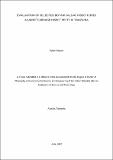| dc.description.abstract | Synthetic pesticides are frequently and unwisely used to control cabbage insect pests by
smallholder farmers despite the environmental pollution and insect pests’ resistance
development. This work assessed the insecticidal efficacy of botanicals from Tephrosia vogelii,
Croton dichogamus and Syzygium aromaticum against cabbage insect pests in Northern
Tanzania. Firstly, larvicidal action of extracts against Crocidolomia binotalis and Plutella
xylostella larvae was assessed in the laboratory. Secondly, insecticidal and synergistic actions
of aqueous extracts against cabbage insect pests were assessed in field experiment. Lastly,
chemical compounds in S. aromaticum and in C. dichogamus were determined. The larvicidal
activities of extracts were assessed for mortality of ten larvae into 9 cm Petri-dishes for 24
hours of exposure. Chlorpyrifos and acetone were used as a positive and negative control,
respectively. The insecticidal efficacy of 10%, 5% and 1% w/v of T. vogelii, C. dichogamus
and S. aromaticum aqueous extracts and their mixture (2.5% and 5%) was assessed against
cabbage insect pests in the field. Chlorpyrifos was used as a positive control, and water and
water plus soap were used as negative controls. The GC-MS was used for compounds
identification in C. dichogamus and in S. aromaticum. Results from the study revealed that S.
aromaticum extract (16, 24 and 32 mg/mL), T. vogelii (24 and 32 mg/mL) and C. dichogamus
(32 mg/mL) gave 100 ± 0.0% mortality of C. binotalis larvae after 24 hours of exposure.
Moreover, S. aromaticum extract (8, 16, 24 and 32 mg/mL), T. vogelii (16, 24 and 32 mg/mL)
and C. dichogamus (32 mg/mL) gave 100 ± 0.0% mortality of P. xylostella larvae after 24
hours of exposure. The aqueous extracts from those plants significantly (P ≤ 0.05) lowered the
population of cabbage insect pests compared with negative controls. The 5% of aqueous extract
from mixed plants possessed significantly (P ≤ 0.01) lower population of cabbage insect pests
in both wet seasons compared with other concentrations. Then, it was followed by 10% of S.
aromaticum, C. dichogamus and T. vogelii aqueous extracts and 1% and 5% of aqueous extracts
of S. aromaticum, C. dichogamus and T. vogelii and 2.5% of aqueous extracts from the mixed
plants significantly lowered the population of insect pests compared with negative controls in
both seasons. The compounds identified in S. aromaticum, at higher percent were Eugenol
(52.66%); Eugenol acetate (20.46%) and β-caryophyllene (7.52%). Moreover, the compounds
identified in C. dichogamus at higher percent were 4,6-Bis (4-chloro-3-(trifluoromethyl)
phenoxy)-2-pyrimidinol (25.08%); Cholestan-6-en-3-ol (18.63%) and 1-Heptadecene (7.34%).
These compounds could be responsible for larvicidal and insecticidal activities against cabbage
ii
insect pests. Therefore, these plants can be recommended to be used by smallholder farmers
for cabbage insect pest control at higher concentrations and development of insecticides. | en_US |

